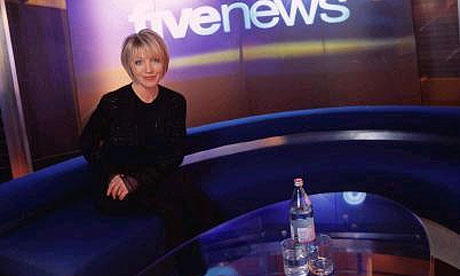Richard Desmond's new channel has suffered for being an afterthought terrestrial broadcaster in a digital age

Among the millions of words it has broadcast, Five (formerly Channel 5) will be remembered in broadcasting history for three spoken off-screen: the "films, football and fucking" reference to its scheduling policy, made by early director of programmes Dawn Airey.
As it happens, Airey was trying to reject such a depiction of her network, rather than endorsing it, but the mud spun back and stuck. This unfortunate reputation is unlikely to be lost by a takeover from Richard Desmond, whose media empire has never bothered much with movies or soccer but has long profited from sex. Cynics will expect that, under Desmond's stewardship, the fifth channel will broadcast rather more of the third F.
In fact, until it was wrecked by the pressure of being an afterthought terrestrial broadcaster in a culture where the focus was already shifting to digital and internet services, Five's formula was always more complicated than that trio from the sixth letter of the alphabet.
Another alliterative way of summarising its formula would be: Neighbours, necrosis and news. It outbid the BBC for the Australian soap opera, as part of a desperate struggle to take ratings from the BBC and advertising revenue from ITV and Channel 4, while – as part of the same strategy of buying recognisable hits – whole hours of the evening schedules have recently been filled by necrotic tissue, in the various spinoffs of the CSI forensic franchise.
The network's contributions in news, though, are likely to be seen as its main legacy to television. Few felt, in 1997, that the medium was short of current affairs coverage, but Five used a simple expedient – female solo anchors in a more informal setting – to develop territory separate from its terrestrial rivals' men-at-desks approach. The early evening bulletins made stars of Kirsty Young and then Natasha Kaplinsky.
This promotion of women newsreaders might be seen as feminist but, as often with this channel, Five will be remembered for its worst endeavours in this department rather than its best: paying £250,000 compensation to Selina Scott for age discrimination after offering, then withdrawing, a job.
There have even been spells when the broadcaster's calling cards might have been encapsulated as Matisse, Mandela and Muhammad. Astonishing as it may come to seem to media historians – especially if Desmond fulfils the worst expectations of observers – there was a time when Five specialised, in early evening peak time, in shows in which Tim Marlow delivered a monologue on an artist or art show. On other occasions, the same slot was filled with profiles of great political or religious leaders.
Such shows brought critical plaudits and guilty readjustments at rival broadcasters (Five's strategy encouraged the BBC to increase TV arts coverage) but failed to deliver ratings or revenue. So it moved to programmes – including one in which alleged Beckham temptress Rebecca Loos hand-pleasured a pig – that surrendered what critical reputation it had. The fear for Desmond's regime is that posterity will judge the pig scene to have been a relative model of good taste.
![Validate my Atom 1.0 feed [Valid Atom 1.0]](valid-atom.png)
























































